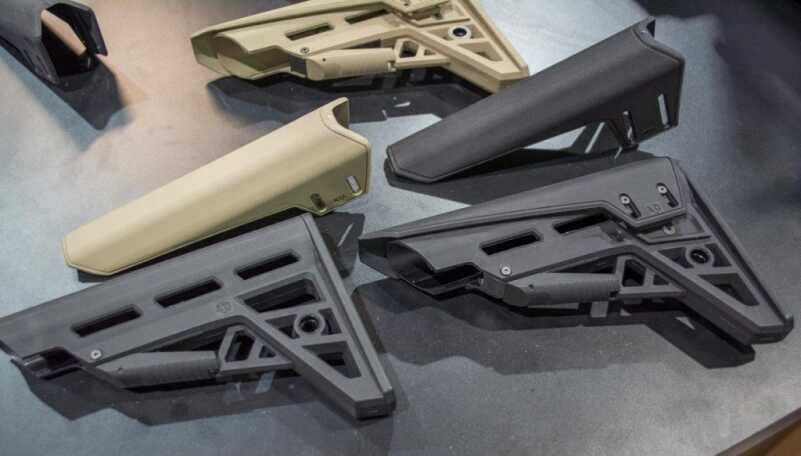
The new ATI TactLite AR stocks. The standard model is on the left and adjustable comb model on the right.
You might have noticed that most adjustable butt stocks for AR-type rifles shake just a little. Worse yet, the farther you move that adjustable stock back, the more the shake. We’ve probably learned just to accept it, kind of like that “sproing” sound that many ARs used to make when fired.
While the movement of the stock on the buffer tube is not a desired design feature, there’s actually a reason it happens. Here’s why. Most stock pieces are made of polymer (plastic of some sort) and are manufactured using injection molding. You slather a bunch of melted plastic glue into a mold. Then, when it hardens, you remove the finished part from the mold. When you’re making a mold that’s intended to fit around a perfect cylinder shape, like a buffer tube, you can’t make the part an exact mirror image of that cylinder, else it will get stuck in the mold. To solve that problem, most manufacturers make the interior of their butt stocks slightly tapered. The innermost portion is the proper dimension for the buffer tube, but the cavity gets a bit larger as you move towards the opening at the front of the stock. Voila! The cavity is a bit larger than it needs to be, hence the shake.
I talked to G. Schneider, Lead Engineer at SHOT Show and asked him why ATI set about inventing a new stock design. “We heard customers complain about the shake with existing stocks. We didn’t want to design a stock with multiple parts to solve that problem – we wanted a single piece unit that was in the six ounce weight range.”
The new TactLite six-position AR stock from ATI was designed expressly to eliminate that problem. Rather than mold the entire butt stock as a single piece, ATI makes a separate insert that rides over the ridge in the buffer tube. The insert itself is made of a polymer called Delrin, which is apparently super slippery. By making the stock this way, the size can more closely replicate the exact dimensions of the buffer tube, thereby eliminating the shake. Regardless of where the stock is positioned, it’s rock solid on the rifle.
I first saw a prototype of this at the National Association of Sporting Goods Wholesalers show last fall, but now it’s available for purchase. Launched at SHOT Show, the new stock is offered in several configurations. You can buy the stock with commercial or mil-spec buffer tube dimensions or you can purchase a complete buffer tube and stock assembly. ATI also offers a variant with an adjustable comb that allows you to set desired cheek weld height to match your optic mount of choice.
One other thing to note. The stock features interior ribs designed to trap and eject debris. Even with a tight fit to the buffer tube, the stock is designed to operate properly in dusty and dirty conditions.
The adjustment lever is designed to prevent snag-free operation and the stock includes a slot for sling use and a quick detachment point accessible from either side. A thin rubber butt pad rounds out the package.
MSRP of the stock is $49.99. Stock and buffer tube combination retails for $94.99 or $99.99 and the adjustable comb model lists for $69.99.


Having worked in the industry(injection molding) for many years, Delrin is a good choice. it’s slicker than snot, and holds tolerances fairly well for a polymer. Nice job, ATI.
A couple of years ago I was shopping for my first AR 15. I picked up many AR’s and all of them “rattled or shook”. I hated that. I ended up with a Colt LE 6920. No rattle or shake. I guess Colt Defence figured out the fix a long time ago. I’m glad that ATI figured it out to give more options.
Yup–the taper in the cavity you speak-of is called “draft” in the injection mold industry. External part surfaces generally need it too and it creates many design trade-offs and compromises in precision-fit injection molded parts. The other limitation, compared to machined or even MIM parts, is plastic just doesn’t hold very close tolerances–a few thousandths of an inch are typical tolerance specs.
It’s common to break a part up into more than one part to solve the problem of tolerance and precision fit design targets. Despite Schneider’s claim that ATI “didn’t want to design a stock with multiple parts to solve that problem,” that is exactly what ATI did, and it looks like they employed a good solution in the form of the additional Delrin part.